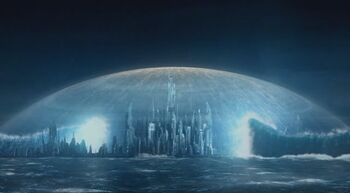
Not generally big or powerful enough to protect a city from a tidal wave
Deflector Shields are magnetic fields produced by a starship to deflect away particles of interplanetary gas and dust, as well as small micrometeorites. Even individual hydrogen atoms become deadly ionizing radiation when travelling at half the speed of light. A low-power free-electron laser sweeps space directly ahead of a starship, giving such particles a tiny electric charge, which enables the fields to push them aside. Non-charged particles are not affected, so most ships have at least some armor on their forward side. Deflector shields are far too weak to be of any use against most weaponry, although plasma and certain types of charged-particle beams can be deflected or attenuated. The equipment needed to produce a properly-shaped and powerful enough deflector shield is too heavy and bulky for use on starfighters or shuttlecraft, so they are limited toabout 300,000 kph by their onboard shielding (about 83 kps, or 1 percent of thespeed of light).
Large warships equipped with a second-generation Gravity Drive can use their main engines to project a spherical shell of focused gravitartional distortion around the ship, crushing incoming projectile weapons to dust and diffracting or attenuating incoming laser beams. These are often mistakenly called Deflector Shields by novices, but are properly known as Gravitic Shields. Such shields are of limited use, however, as while projecting them, the ship's engines cannot be used to maneuver, even auxilliary ion drives. Also, the same field that will destroy incoming enemy missiles will crush your own and cause your own laser beams to lose coherence and focus, so you cannot fire out of such a field any more than you can fire into it. However, the Jurvain have managed to find a way to project "portholes" in the Gravitic Shields around their dreadnoughts, enabling them to at least fire while shielded, although these portholes also can be fired into, and thus constitute a small weakness. The difficulty of hitting such a small target at typical starship engagement distances makes this not much of a weakness, much to the dismay of their opponents.